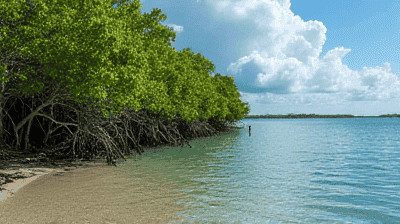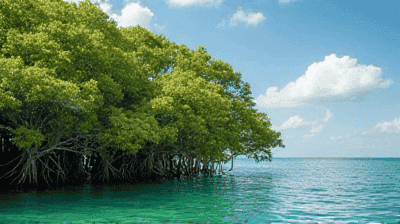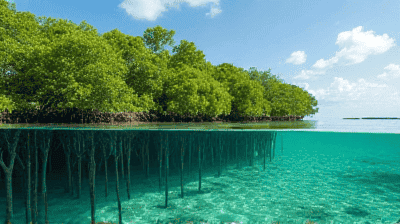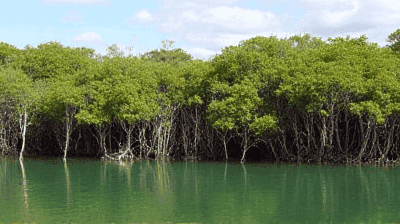
Mangroves are among the most productive and biologically diverse ecosystems on the planet. Thriving in coastal intertidal zones, these unique trees and shrubs play a vital role in safeguarding coastal areas from environmental threats while simultaneously sequestering carbon dioxide from the atmosphere. As climate change leads to rising sea levels and increased hurricane intensity, the importance of mangrove restoration has become critical for both ecological stability and climate mitigation.
Mangroves are salt-tolerant trees and shrubs that grow in coastal intertidal zones. They are characterized by their complex root systems, which often protrude above the waterline, creating a distinctive habitat that supports various marine and terrestrial species. There are approximately 70 species of mangroves found in over 123 countries, primarily in tropical and subtropical regions.
Mangroves serve several critical ecological functions:
Habitat for Biodiversity: Mangrove forests provide shelter and breeding grounds for numerous species, including fish, crustaceans, birds, and reptiles. Many commercially important fish species, such as snapper and grouper, rely on mangrove ecosystems during their juvenile stages.
Coastal Protection: The dense root systems of mangrove trees stabilize shorelines, reducing erosion and protecting coastal areas from storm surges, high waves, and flooding, especially during strong storms and hurricanes.
Water Filtration: Mangroves filter pollutants and sediments from water, improving water quality and promoting healthy coastal ecosystems.
Carbon Sequestration: Mangrove forests capture and store carbon dioxide at rates higher than most terrestrial ecosystems. This capacity for carbon sequestration is essential for climate change mitigation.
Mangroves are divided into several families and species, each adapted to specific environmental conditions. Some notable mangrove species include:
Red Mangrove (Rhizophora mangle): Recognizable for its prop roots, the red mangrove thrives in the water and provides critical habitat for many aquatic species.
Black Mangrove (Avicennia germinans): Adapted to high salinity, the black mangrove has specialized structures called pneumatophores that project above the soil, allowing the tree to breathe in oxygen.
White Mangrove (Laguncularia racemosa): This species typically grows farther inland and has adaptations for salt tolerance, such as salt-excreting glands.

Despite their ecological and economic significance, mangroves face numerous threats that jeopardize their survival:
Rapid urbanization, infrastructure development, agriculture, and aquaculture have led to the destruction of mangrove ecosystems. Coastal areas are often prioritized for development due to their proximity to water, resulting in the clearing of mangroves for land use.
Climate change poses significant risks to mangrove ecosystems. Rising sea levels can inundate mangroves, affecting their growth and survival, while changing weather patterns can impact their health and resilience. Increased storm intensity can also lead to physical damage.
Pollution from agricultural runoff, industrial discharges, and waste contributes to mangrove degradation. Excess nutrients and toxins can distort the balance of mangrove ecosystems, harming flora and fauna.
Overharvesting of mangroves for timber, fuelwood, and charcoal can lead to the rapid loss of these vital habitats. Unsustainable fishing practices can further disrupt the complex interdependencies in mangrove ecosystems.
Invasive plant species can outcompete native mangrove species, altering the community composition and reducing biodiversity. The introduction of non-native species, often for ornamental or agricultural purposes, can profoundly affect mangrove health.
Mangroves act as natural barriers to coastal hazards. Their dense root systems trap sediments and stabilize shorelines, significantly reducing erosion and the impact of storm surges and high waves. Restoring mangroves can thus play a crucial role in protecting coastal infrastructure, communities, and ecosystems from the impacts of climate change.
Restoration of mangrove ecosystems fosters the recovery of numerous species that depend on these habitats. Increased biodiversity contributes to healthier ecosystems, which are more resilient to environmental stressors.
Mangroves have a remarkable capacity for carbon sequestration, storing carbon in their biomass and in the soil beneath them. This makes them one of the most efficient ecosystems in terms of carbon capture per unit area. By restoring mangroves, we can enhance their role as carbon sinks and help mitigate climate change.
Restored mangrove ecosystems can improve water quality by filtering pollutants and excess nutrients from coastal waters. This is crucial for maintaining the health of marine environments and supporting fisheries.
Healthy mangrove ecosystems provide vital resources and services to local communities. They support fisheries, ecotourism, and sustainable forestry, contributing to economic development while promoting environmental stewardship.

Restoration of mangrove ecosystems requires a combination of scientific knowledge, effective management, and community involvement. Here are key strategies to consider:
Before initiating restoration efforts, a thorough assessment of the site is essential. This includes evaluating the condition of existing mangrove areas, soil health, hydrology, and surrounding land use. Understanding these factors helps inform the restoration approach and ensures its effectiveness.
Choosing the right species for restoration is critical. Native mangrove species that are well-adapted to local conditions should be prioritized. This selection promotes ecological integrity and supports biodiversity.
Assisted natural regeneration is an effective method for restoring mangroves. This approach involves protecting existing mangrove seedlings and allowing natural processes to facilitate recovery. It may also include removing invasive species and implementing measures to support seedlings' growth.
Designating buffer zones around mangrove restoration sites can help protect against external threats. These zones can mitigate the impacts of pollution and human activities, allowing mangroves to thrive and maintain their ecological functions.
Involving local communities in restoration efforts is essential for long-term success. Education and outreach programs can raise awareness of the significance of mangroves, foster stewardship, and ensure local participation in restoration activities.
Implementing a robust monitoring program is vital for assessing restoration success and identifying challenges. Regular monitoring allows for adaptive management, enabling adjustments to restoration strategies as needed to achieve desired outcomes.
Government support and funding for mangrove restoration projects are critical. Policies that prioritize the conservation and restoration of mangroves can facilitate effective implementation and ensure the necessary resources are available.
In Madagascar, the Blue Carbon Project focused on mangrove restoration to enhance coastal protection and carbon sequestration. Through community engagement and effective management practices, local stakeholders participated in planting native mangrove species and protecting existing forests. This initiative successfully restored degraded mangrove areas, providing vital ecosystem services while enhancing community livelihoods through sustainable fishing.
Indonesia is home to some of the world's largest mangrove forests, yet significant deforestation has occurred. The Mangrove Restoration Initiative aims to restore 1 million hectares of mangroves by 2025. This program emphasizes community involvement, encouraging local people to take part in planting and monitoring efforts. The initiative has already seen the restoration of vast areas, leading to improved biodiversity and increased carbon sequestration.
Louisiana has been severely impacted by coastal erosion driven by human activities and climate change. The Coastal Restoration Project incorporates mangrove restoration as a key strategy for protecting coastal habitats and communities. Efforts include restoring degraded wetlands, planting mangroves, and building protective barriers. This multifaceted approach has contributed to coastal resilience, reduced flooding, and enhanced habitat for fish and wildlife.
The Sundarbans, a UNESCO World Heritage site, is the largest mangrove forest in the world, encompassing parts of India and Bangladesh. Restoration efforts in this area focus on enhancing the resilience of local communities to climate change by restoring mangrove ecosystems. Projects have included the planting of native species and protecting natural regeneration areas, leading to improved coastal protection, habitat restoration, and carbon sequestration.

Remote sensing technologies, including satellite imagery and drones, can provide valuable data for assessing mangrove health and acreage. This information helps identify areas in need of restoration and allows for monitoring over time.
GIS technology can aid in site assessment and planning by analyzing spatial data related to mangrove ecosystems. This tool can help identify critical areas for protection and restoration while supporting effective management strategies.
Mobile applications can facilitate community engagement and data collection on mangrove health and restoration efforts. These platforms allow local residents to report changes and support monitoring efforts, fostering a sense of ownership.
Despite the many benefits and strategies for mangrove restoration, several challenges persist:
Securing sufficient funding for restoration initiatives can be challenging, particularly in regions where economic resources are limited. Innovative financing mechanisms, such as blue carbon credits and public-private partnerships, may help address funding gaps.
The effects of climate change, including rising sea levels and increased storm intensity, can pose significant challenges to restoration efforts. Developing adaptation strategies that account for these variables is essential for long-term success.
Conflicts between land use for agriculture, development, and conservation can impede restoration efforts. Effective land-use planning and stakeholder engagement are vital for addressing these challenges.
Lack of technical expertise and monitoring capacity can hinder restoration projects. Providing training and building local capacity are essential for empowering communities and ensuring successful project implementation.
As awareness of the importance of mangroves grows, the future of mangrove restoration looks promising. Key areas for focus include:
Collaboration among governments, NGOs, communities, and researchers will be vital for successful mangrove restoration efforts worldwide. Sharing knowledge, resources, and best practices can enhance effectiveness and expand restoration initiatives.
Advocating for policies that prioritize mangrove conservation and restoration can create an enabling environment for successful projects. Integrated approaches that emphasize ecosystem-based management will be essential.
Raising awareness about the importance of mangroves among policymakers, businesses, and local communities can drive support for restoration efforts. Education programs should emphasize the ecological and economic benefits of mangrove ecosystems.
Continued research into methodologies and technologies for mangrove restoration is necessary. Innovative approaches, such as using genetic techniques to enhance resilience, may contribute to the success of restoration efforts.
Mangrove restoration is critical for coastal protection and carbon sequestration, offering a powerful means of safeguarding ecosystems and mitigating climate change. By understanding the ecological significance of mangroves, addressing the threats they face, and implementing effective restoration strategies, we can work toward a sustainable future.
Prioritizing mangrove restoration not only benefits the environment but also supports coastal communities, enhances biodiversity, and contributes to climate resilience. As global efforts intensify to combat climate change, restoring mangrove ecosystems must be recognized as an urgent and essential component of our response.